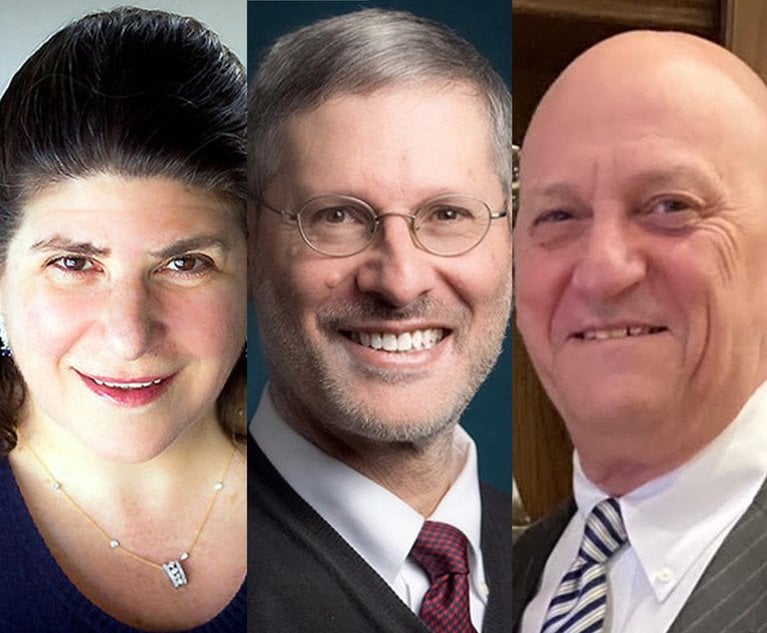 L-R Elisa Reiter and Daniel Pollack. Courtesy Photos
L-R Elisa Reiter and Daniel Pollack. Courtesy Photos The Legal Profession Needs Some Bullying Prevention and Intervention Strategies
"The distinction between bullying behavior and proper advocacy in the courthouse hinges on respect, professionalism and adherence to ethical standards," write Elisa Reiter and Daniel Pollack.
July 31, 2024 at 10:00 AM
6 minute read
A young lawyer with a hard-to-pronounce name is bullied by an older opposing counsel. First, the older opposing counsel sends repeated communications in which he misspells the young associate's name. Second, when first meeting in person, the older attorney observes that the young associate wears a weighty ring on her right hand. When shaking hands, he uses a significant amount of pressure so that the young woman experiences pain when her middle finger and pinkie are crushed against her ring finger. What to do? The young associate seeks counsel from the gray-haired partner at the end of the hall and from family. The gray-haired partner suggests that she address the opposing counsel as only "Billy Bob" in future communications. A family friend suggests a jiu jitsu move that allows the young woman to transfer the pressure intended for her own hand back on the opposing counsel when they next meet and exchange handshakes. She does both. The opposing counsel stops misspelling and mispronouncing her name, and he now shakes her hand respectfully.
Litigation lends itself to bullying behavior by judges, attorneys, litigants, and witnesses. Bill Eddy, in his recent book, "Our New World of Adult Bullies, How to Spot Them, How to Stop Them," contends that "[a]dult bullies have high-conflict personalities," concluding that such individuals share the following characteristics:
- They habitually deflect responsibility by attributing fault to others, rarely acknowledging their own role in situations.
- Their worldwide view tends to be polarized, categorizing people and situations into stark, opposing extremes, with no middle ground.
- They frequently display intense and disproportionate emotional reactions to events or circumstances.
- Their behavior often included highly destructive or unethical actions that fall far outside societal norms and typical moral boundaries.
Impact of Social Media and Technology
Social media and technology do not inherently condone bullying behavior, but they can facilitate and amplify it in several ways:
- Increased accessibility and reach: Social media platforms and digital technologies provide bullies with constant access to their targets. Harassment can occur 24/7 on the internet, potentially to a wide audience.
- Anonymity and distance: The digital environment can create a sense of detachment, allowing individuals to engage in harmful behavior without immediately being privy to consequences or repercussions. That anonymity emboldens some to behave more aggressively than they would in an interaction that is in person.
- Rapid spread of information: Social media allows for quick dissemination of content, be it good or bad. Sadly, bad content includes rumors, embarrassing photos, and private information. That ready availability magnifies the impact of bullying, compromising the ability of victims to escape or control the situation.
- New forms of harassment: Technology provides the bully with novel ways to bully, including cyberstalking, sending explicit images without consent, and creating fake profiles to "catfish" or mock others.
- Permanence of digital content: Information shared online can persist indefinitely.
- Normalization of negative behavior: Cyberbullying is so present in today's world that we have become desensitized to its harmful impact.
Recognizing Bullying at the Courthouse
Distinguishing bullying behavior from proper advocacy in a courthouse or litigation setting involves recognizing specific characteristics and tactics commonly associated with each. Key distinctions include:
- Intimidation and coercion: Bullying manifests as intimidation tactics and undermining an opponent's confidence or ability to advocate effectively. This can include aggressive questioning, threats, or attempts to provoke fear in the opposing party or their legal representatives.
- Unprofessional conduct: Think public humiliation, derogatory remarks, or disrespectful treatment of clients, witnesses, or court staff. Such behavior is aimed at asserting dominance rather than pursuing a legitimate legal strategy.
- Manipulation of court procedures: Bullies tend to file excessive motions and/or seek unnecessary delays to prolong litigation. Such tactics create an oppressive atmosphere that hinders fair advocacy in litigation.
- Lack of respect for legal boundaries: Bullies focus on winning at any cost. Ethical standards and legal boundaries are irrelevant to the bully. Bullies do not feel hampered by making false statements, misrepresenting facts, or using confidential information against an opponent.
- Projection: Decision makers may need assistance in understanding that when someone takes an extreme position, they may in fact be attributing their own misdeeds to the opposing party.
Proper Advocacy
How to spot proper advocacy versus the bullying behavior outlined above? Ethical advocacy involves the following:
- Respectful engagement: Proper advocacy involves engaging with everyone respectfully, while maintaining professionalism, even in adversarial settings. Advocates aim to represent their clients' interests zealously, within the bounds of ethical canons, without resorting to intimidation or disrespect.
- Strategic argument: Attorneys focus on presenting logical arguments, supported by statute and precedent. They persuade the court, based on the merits of the case, rather than through coercive tactics.
- Collaboration and communication: Effective advocacy includes open communication, but does not condone ex parte communication with the court. Attorneys should work collaboratively and when appropriate, aim to resolve disputes amicably and efficiently.
Strategies to Overcome Bullies in Litigation
The distinction between bullying behavior and proper advocacy in the courthouse hinges on respect, professionalism, and adherence to ethical standards. Bullying tactics at the courthouse are characterized by intimidation and manipulation. Effective advocacy focuses on respectful engagement and strategic argument. Argue the facts. Argue the law. Zealously represent the client within the bounds of the law. Combating bullying behavior at the courthouse means that you, and your client, must maintain composure. Reacting emotionally simply empowers the bully. Document. Document everything. Keep detailed chronological notes and records of bullying behavior, including dates, times, and specific incidents. Recognize that your client may be enduring bullying tactics by their spouse in the context of a divorce or modification. Communicate frequently on how to best handle the situation. Establish boundaries. Accept the fact that your client may need to defer all communications to you, rather than communicating directly with their spouse.
This content has been archived. It is available through our partners, LexisNexis® and Bloomberg Law.
To view this content, please continue to their sites.
Not a Lexis Subscriber?
Subscribe Now
Not a Bloomberg Law Subscriber?
Subscribe Now
NOT FOR REPRINT
© 2025 ALM Global, LLC, All Rights Reserved. Request academic re-use from www.copyright.com. All other uses, submit a request to [email protected]. For more information visit Asset & Logo Licensing.
You Might Like
View All

Trending Stories
- 1Legaltech Rundown: McDermott Will & Emery Invests $10 million in The LegalTech Fund, LexisNexis Releases Conversational Search for Nexis+ AI, and More
- 2The TikTokification of the Courtroom
- 3New Jersey’s Arbitration Appeal Deadline—A Call for Clarity
- 4Law Firms Look to Gen Z for AI Skills, as 'Data Becomes the Oil of Legal'
- 55th Circuit Strikes Down Law Barring Handgun Sales to Adults Under 21
Who Got The Work
J. Brugh Lower of Gibbons has entered an appearance for industrial equipment supplier Devco Corporation in a pending trademark infringement lawsuit. The suit, accusing the defendant of selling knock-off Graco products, was filed Dec. 18 in New Jersey District Court by Rivkin Radler on behalf of Graco Inc. and Graco Minnesota. The case, assigned to U.S. District Judge Zahid N. Quraishi, is 3:24-cv-11294, Graco Inc. et al v. Devco Corporation.
Who Got The Work
Rebecca Maller-Stein and Kent A. Yalowitz of Arnold & Porter Kaye Scholer have entered their appearances for Hanaco Venture Capital and its executives, Lior Prosor and David Frankel, in a pending securities lawsuit. The action, filed on Dec. 24 in New York Southern District Court by Zell, Aron & Co. on behalf of Goldeneye Advisors, accuses the defendants of negligently and fraudulently managing the plaintiff's $1 million investment. The case, assigned to U.S. District Judge Vernon S. Broderick, is 1:24-cv-09918, Goldeneye Advisors, LLC v. Hanaco Venture Capital, Ltd. et al.
Who Got The Work
Attorneys from A&O Shearman has stepped in as defense counsel for Toronto-Dominion Bank and other defendants in a pending securities class action. The suit, filed Dec. 11 in New York Southern District Court by Bleichmar Fonti & Auld, accuses the defendants of concealing the bank's 'pervasive' deficiencies in regards to its compliance with the Bank Secrecy Act and the quality of its anti-money laundering controls. The case, assigned to U.S. District Judge Arun Subramanian, is 1:24-cv-09445, Gonzalez v. The Toronto-Dominion Bank et al.
Who Got The Work
Crown Castle International, a Pennsylvania company providing shared communications infrastructure, has turned to Luke D. Wolf of Gordon Rees Scully Mansukhani to fend off a pending breach-of-contract lawsuit. The court action, filed Nov. 25 in Michigan Eastern District Court by Hooper Hathaway PC on behalf of The Town Residences LLC, accuses Crown Castle of failing to transfer approximately $30,000 in utility payments from T-Mobile in breach of a roof-top lease and assignment agreement. The case, assigned to U.S. District Judge Susan K. Declercq, is 2:24-cv-13131, The Town Residences LLC v. T-Mobile US, Inc. et al.
Who Got The Work
Wilfred P. Coronato and Daniel M. Schwartz of McCarter & English have stepped in as defense counsel to Electrolux Home Products Inc. in a pending product liability lawsuit. The court action, filed Nov. 26 in New York Eastern District Court by Poulos Lopiccolo PC and Nagel Rice LLP on behalf of David Stern, alleges that the defendant's refrigerators’ drawers and shelving repeatedly break and fall apart within months after purchase. The case, assigned to U.S. District Judge Joan M. Azrack, is 2:24-cv-08204, Stern v. Electrolux Home Products, Inc.
Featured Firms
Law Offices of Gary Martin Hays & Associates, P.C.
(470) 294-1674
Law Offices of Mark E. Salomone
(857) 444-6468
Smith & Hassler
(713) 739-1250








